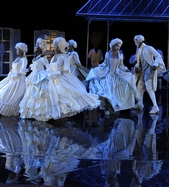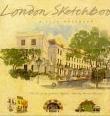SITE GUIDE
SEARCH
REVIEWS
REVIEW ARCHIVES
ADVERTISING AT CURTAINUP
FEATURES
NEWS
Etcetera and
Short Term Listings
LISTINGS
Broadway
Off-Broadway
NYC Restaurants
BOOKS and CDs
OTHER PLACES
Berkshires
London
California
New Jersey
DC
Philadelphia
Elsewhere
QUOTES
TKTS
PLAYWRIGHTS' ALBUMS
LETTERS TO EDITOR
FILM
LINKS
MISCELLANEOUS
Free Updates
Masthead
Writing for Us
A CurtainUp  London Review
London Review
 London Review
London ReviewDeath and the King's Horseman
| The gods demanded only the old expired plantain but you cut down the sap-laden shoot to feed your pride. — Iyaloja
|

Cast members in Ball Scene (Photo: Robbie Jack) |
Wole Soyinka's famous post colonial play Death and the King's Horseman comes to the National Theatre's largest Olivier space with Rufus Norris directing. We know that Rufus Norris will give us something with a memorable staging but this play is already being talked about for the casting of black actors in the parts of the British colonial rulers.
Black actors playing white roles is not unusual in Nobel Laureate's Soyinka's native Nigeria but what is unusual is the white makeup the black actors wear, a negative image of the reviled black make up worn by white male singers in the manner of Al Jolson or in the 1960s for BBC television's The Black and White Minstrel Show. Lucian Msamati (I always think the Zimbabwean actor sounds like a very fast car), who is currently playing the charming JLB Matekoni, Precious Ramotswe's love interest in Anthony Minghella's Botswana set No 1 Ladies' Detective Agency, makes an excellent and sympathetic job of the British colonial administrator and District Officer Simon Pilkings. Jenny Jules, almost unrecognizable in a dark blonde wig and white face takes on his wife Jane.
I must confess I found much of the first act a yawn with its obscure Yoruban cultural parables and riddles as related by the King's Horseman, Elesin (Nonso Amozie), statuesque but all too often incomprehensible, both in diction and meaning. Giles Terera as the Praise Singer leads the excitingly lit (Paule Constable) dances choreographed by the very talented Javier de Frutos. Far more diverting is it to watch Norris and de Frutos' 1943 village scenes, the wonderful shimmying haystack bushes or the tree figures which people the stage or the roped blue bags of laundry which stretch and radiate out on washing lines as the Horseman is re-robed from red to blue cloth for his wedding immediately prior to his planned ritual suicide. There are statues to give the impression of a very fully peopled market place and actors trading with baskets, on their heads, full of red chilli peppers or fruit and vegetables, even cages of poultry. There are Magritte like characters with heads like brooms or thorn bushes giving an air of Disney's broomsticks in The Sorcerer's Apprentice.
The light relief comes with Rufus Norris' spectacular staging and the brilliant costumes and design by Katrina Lindsay but even these delights could not fully lift the tedium of the dialogue or the caricature of some of the penned performances. The storyline does get better in the second half as the effect of the colonial interference is explained and weighed.
I disliked much of the pantomimic humour of the play which centres on African women parodying and lampooning the colonial masters or with vulgar, explicit sexual bullying of the policemen. The white face ball in the style of Louis XVI is spooky and impressively staged. Some actors are joined to two dummies on a wooden yoke to make the ballroom seem quite crowded with dancers. Flunkies stand behind louvred windows to give the impression of a large colonial mansion. The Pilkings' go to the ball in dubious taste fancy dress, sporting red, ancestral, carpet layered robes which are worn by witch doctors and are seen by the Africans as both frightening and disrespectful. Standard lamps and other furniture also comes to life and yes, it's fun, but don't ask me why? Olunde, Elesin's eldest son (Kobna Holbrook-Smith), educated in Britain as a doctor and a success in both English and African society, challenges the wearers, "Is that the good cause for which you desecrate an ancestral mask?" The clash of cultures ends badly with the imposition of European ideas on an African nation and with Elesin's sexual greed also impeding his traditionally expected death . Claire Benedict as Elesin's mother curses the yet living Horseman as the tragedy concludes.
Wole Soyinka's statement that ritual suicide is analogously akin to British soldiers dying in war for their country doesn't cut the mustard but at least his play makes us think about the negative outcome of colonial rule. Norris' production is both beautiful and alien.
Go here for the play reviewed in Washington and further plot details
| Death and the King's Horseman
Written by Wole Soyinka Directed by Rufus Norris Starring: Claire Benedict, Nonso Anozie, Lucian Msamati, Kobna Holdbrook-Smith, Jenny Jules, Giles Terera With: David Ajala, Medina Ajikawo, Sarah Amankwah, 'Kemi Durosinmi, Robert Eugene, Derek Ezenagu, Karlina Grace, Gemma McFarlane-Edmond, Coral Messam, Rex Obano, Anthony Ofoegbu, Demi Oyediran, Daniel Poyser, Jason Rowe, Seun Shote, David Webber Design: Katrina Lindsay Lighting: Paule Constable Sound: Ian Dickinson Band Music: Matthew Scott Puppet Co-ordinator: David Cauchi Associate Director /Consultant/Lyrics: Peter Badejo Vocal Arranger and Musical Director: Michael Henry Choreographer and Movement Director: Javier de Frutos Running time: Two hours 40 minutes with an interval Box Office: 020 7452 3000 Booking to 17th June 2009 Reviewed by Lizzie Loveridge based on 13th April 2009 performance at the Olivier, National Theatre, South Bank, London SE1 (Rail/Tube: Waterloo) |
|
REVIEW FEEDBACK Highlight one of the responses below and click "copy" or"CTRL+C"
Paste the highlighted text into the subject line (CTRL+ V): Feel free to add detailed comments in the body of the email . . . also the names and emails of any friends to whom you'd like us to forward a copy of this review. |




